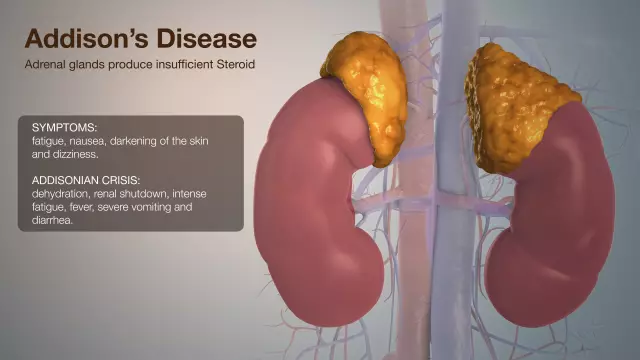- Author Rachel Wainwright [email protected].
- Public 2023-12-15 07:39.
- Last modified 2025-11-02 20:14.
Still's disease
The content of the article:
- Causes and risk factors
- Symptoms
- Diagnostics
- Treatment
- Possible complications and consequences
- Forecast
- Prevention
Still's disease is a systemic disease that manifests itself as polyarthritis, fever, transient skin rashes and inflammatory damage to internal organs.

Cutaneous manifestations of Still's disease
The disease was first described by the English physician George Still in 1897, for many years it was considered one of the forms of juvenile arthritis, that is, inflammation of the joints that develops in children and adolescents. Still's disease was isolated as a separate nosological unit only in 1971, after Eric Bywaters published a scientific work in which he described numerous cases of this pathology observed by him in adult patients.
The prevalence of Still's disease is approximately 1 in every 100,000 population, with the same frequency affecting men and women. It can affect people of any age, but most of the time affects children under 16.
Diagnosis of Still's disease is often difficult, since there are no specific symptoms of the disease. Patients are often erroneously diagnosed with sepsis and repeated courses of antibiotic therapy are prescribed. As medical statistics show, in about 5% of cases, doctors initially interpret the clinical manifestations of Still's disease as symptoms of a fever of unknown origin.
Causes and risk factors
The exact causes of Still's disease are unknown. The infectious nature of the disease is indicated by high fever, lymphadenopathy, leukocytosis, as well as a sudden onset. However, it has not yet been possible to identify a single pathogen. In some patients, cytomegalovirus is isolated, and in others, rubella virus. The literature describes cases of Still's disease associated with Escherichia, mycoplasma, Epstein-Barr viruses and parainfluenza.

The exact causes of Still's disease are unknown, but many symptoms indicate an infectious nature of the disease.
Some patients have a combination of Still's disease with allergic vasculitis. This circumstance suggests an autoimmune genesis of the disease.
It is impossible to completely exclude the presence of a hereditary predisposition, although there is still no precise data confirming the relationship between the pathology under consideration and the HLA loci (human leukocyte antigen).
Symptoms
Still's disease begins acutely with a sudden rise in body temperature to high values. At the same time, fever is unstable, which distinguishes it from fever in common infectious diseases. During the day, there is usually only one peak of temperature rise, observed in the evening hours. Much less often, fever in Still's disease has two peaks in temperature rise. In 80% of patients, in the interval between these peaks, the temperature drops to normal values. The general condition during the indicated period improves significantly. In the rest of the patients, in the inter-peak period, the temperature decreases only to subfebrile values.

Still's disease begins with a sudden rise in temperature
At the height of the fever, transient skin eruptions appear. The rash is mainly represented by macules (pink flat spots) and papules. It is localized on the trunk and proximal extremities, much less often on the face. In about 30% of cases, the rash is located in places where the skin is compressed or injured (Kebner's symptom). Very rarely, Still's disease may be accompanied by the appearance of atypical cutaneous manifestations (eg, erythema nodosum or petechiae).
Articular syndrome is observed. The inflammatory process in the initial stages of the disease usually affects one joint, then other joints are drawn into it (hip, knee, ankle, elbow, wrist, metatarsophalangeal, interphalangeal, temporomandibular). The most typical lesion is the distal interphalangeal joints of the hands.

With Still's disease, there is an inflammatory process in the joints
At the onset of the disease, most patients develop a sore throat that is persistent.
Still's disease in 65% of cases is accompanied by damage to the lymphoreticular organs, which is manifested by an increase in the liver and spleen (hepatosplenomegaly), as well as lymph nodes (lymphadenopathy). Most often, the cervical lymph nodes are enlarged. With an atypical course of the disease, necrosis of enlarged lymph nodes may develop.
Diagnostics
The diagnosis of Still's disease is complex and is based on the exclusion of other diseases with similar symptoms (primarily rheumatoid arthritis, systemic lupus erythematosus, rheumatic fever).
Laboratory tests reveal changes characteristic of an active inflammatory process (leukocytosis, increased ESR, increased levels of amyloid A, C-reactive protein, ferritin). At the same time, there are no antinuclear and rheumatoid factors in the blood. A biochemical blood test reveals an increase in the activity of hepatic transaminases.

Laboratory tests can detect signs of inflammation and an increase in the activity of liver enzymes in Still's disease
Repeated bacteriological blood cultures in Still's disease prevent the growth of microbial flora.
X-ray examination of the affected joints reveals the presence of effusion in their cavity. In the analysis of synovial fluid, changes characteristic of the aseptic inflammatory process are detected.
Treatment
Treatment of Still's disease begins with the appointment of non-steroidal anti-inflammatory drugs for at least three months. In 25% of cases, this is enough for recovery.

Non-steroidal anti-inflammatory drugs help 25% of Still's disease
When the disease is chronic, in addition to non-steroidal anti-inflammatory drugs, corticosteroids are used, as well as cytostatic drugs.
Possible complications and consequences
Still's disease is often complicated by pericarditis and / or pleurisy. Every fifth patient has aseptic pneumonitis, the clinical manifestations of which resemble bilateral pneumonia. It:
- fever;
- dyspnea;
- coughing.
Prescribing antibiotics for aseptic pneumonitis does not work.
More rare complications of Still's disease are:
- cardiac tamponade;
- myocarditis;
- respiratory distress syndrome;
- valvular vegetation (proliferation of heart valve tissue).
It can be fatal:
- liver failure;
- amyloidosis;
- heart failure;
- blood clotting disorders.
Forecast
The forecast is generally favorable. The five-year survival rate is 90-95%.
Prevention
Measures to prevent Still's disease have not been developed, since the mechanism of its occurrence is unclear.
YouTube video related to the article:

Elena Minkina Doctor anesthesiologist-resuscitator About the author
Education: graduated from the Tashkent State Medical Institute, specializing in general medicine in 1991. Repeatedly passed refresher courses.
Work experience: anesthesiologist-resuscitator of the city maternity complex, resuscitator of the hemodialysis department.
The information is generalized and provided for informational purposes only. At the first sign of illness, see your doctor. Self-medication is hazardous to health!






